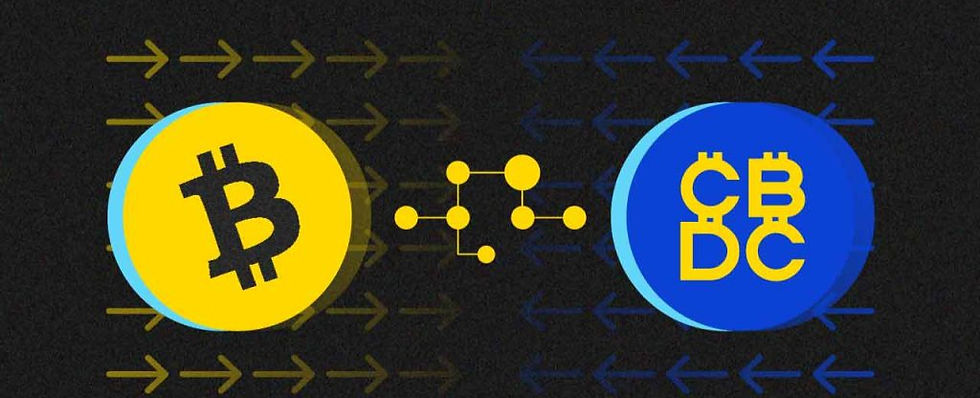CBDCs vs. Crypto: Is Decentralization at Risk?
- Bitcoinsguide.org

- Oct 4
- 2 min read
🧠 Introduction: The Digital Currency Crossroads
As of 2025, over 130 countries are exploring or piloting Central Bank Digital Currencies (CBDCs).
At the same time, decentralized cryptocurrencies like Bitcoin and Ethereum remain strong.
But there's a growing question:
Are CBDCs a technological evolution—or a threat to financial freedom?
Let’s break down the key differences, potential risks, and how crypto holders should prepare.

💡 What Are CBDCs?
CBDCs are digital versions of fiat currencies issued and controlled by a central bank.
Example:
The Digital Euro, e-CNY (China), or FedNow in the U.S.
They’re not cryptocurrencies—they’re centralized, programmable, and tied to national monetary systems.
Key features of CBDCs:
Issued by central banks
Fully regulated
Transactional data is transparent to the state
Can be programmed with restrictions (e.g., expiry dates, spending limits)
How Do CBDCs Differ from Cryptocurrencies?
Feature | CBDCs | Cryptocurrencies |
Issuer | Central banks | Decentralized networks |
Control | Fully centralized | Peer-to-peer, distributed |
Privacy | Limited to none | Depends on the coin (e.g., Monero vs. BTC) |
Supply | Controlled by policy | Often algorithmically fixed (e.g., BTC) |
Programmability | Yes (government-defined) | Yes (user or DAO-defined via smart contracts) |
Purpose | Efficiency, control, surveillance | Freedom, privacy, censorship resistance |
⚠️ Why Are CBDCs Seen as a Threat to Decentralization?
1. Surveillance by Design
CBDCs could allow real-time tracking of every transaction by the government, breaking financial privacy.
🔍 Unlike cash or BTC, CBDCs are not anonymous.
2. Programmable Control
CBDCs could include rules like:
Where you’re allowed to spend
Expiry dates on money
Automatic taxation or freezing
This gives governments immense power over your funds.
3. Crowding Out Crypto
Some fear governments will ban or restrict decentralized crypto once CBDCs are launched, under the guise of "security" or "anti-crime".
🛡️ Why Decentralized Crypto Still Matters
Even with CBDCs, decentralized finance (DeFi) and permissionless networks serve purposes CBDCs cannot:
Bitcoin = digital gold (non-sovereign store of value)
Ethereum = decentralized apps, NFTs, DAOs
Privacy coins = financial autonomy
DeFi = earn yield without banks
Crypto isn’t just money—it’s a parallel system built on transparency and user empowerment.
🌍 What Are Governments Saying?
✅ Common Justifications for CBDCs:
Faster, cheaper payments
Financial inclusion
Reduced fraud and money laundering
Competing with stablecoins and Big Tech
But critics argue it's more about control than convenience.
🔮 What Should Crypto Users Do?
1. Diversify Holdings
Keep a portion of wealth in non-custodial wallets and hardware wallets.
2. Learn About Privacy Tools
Explore privacy-focused solutions like:
Monero
CoinJoin on Bitcoin
Privacy layers on L2s
3. Watch Legal Trends
Follow your country’s crypto policy updates. Be prepared for regulations targeting privacy or self-custody.
4. Support Decentralized Projects
The best way to counter CBDC dominance is to strengthen crypto adoption: use dApps, stake tokens, and educate others.

✅ Final Thoughts: The Future Is Forked
CBDCs and crypto represent two very different futures:
One centralized, monitored, programmable
One open, transparent, user-owned
The battle isn’t just technological—it’s philosophical.
In 2025, decentralization isn’t just a buzzword.
It’s a defense mechanism against digital authoritarianism.



Comments